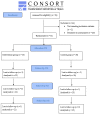HAPPY MAMA Project (Part 2)-Maternal Distress and Self-Efficacy: A Pilot Randomized Controlled Field Trial
- PMID: 35162482
- PMCID: PMC8835492
- DOI: 10.3390/ijerph19031461
HAPPY MAMA Project (Part 2)-Maternal Distress and Self-Efficacy: A Pilot Randomized Controlled Field Trial
Abstract
Introduction: The aim of the pilot randomized controlled field trial is to assess if a midwifery intervention is able to increase the maternal self-efficacy and reduce the stress level during the first six months after birth.
Methods: The study was conducted in two different hospitals in Rome, Italy, involving women delivering at or beyond term, aged >18 years old and with normal APGAR scores of the infant. The participants were randomly divided into two groups: "Individual Intervention Group" (they received home midwifery assistance for one month after birth, I) and the "Control Group" (C). A self-administered questionnaire was administered four times: at the baseline about one week after the hospital delivery (T0), after the intervention about one month after the delivery (T1), and at three months (T2) and at six months after birth (T3). The questionnaire included different validated scales needed to assess maternal perceived self-efficacy (KPCS), parental stress scale stress (PSS) and maternal depressive risk symptoms (EPDS).
Results: The study population counted 51 mothers: 28 women in the "C" group and 23 women in the "I" group. The PSS score was statistically higher in the "C" than "I" group at T1 (p = 0.024); whereas the KPCS score was statistically higher in the "I" (p = 0.039) group; EPDS score did not show significant difference between the two groups in the follow-up period. An inverse significant correlation between KPCS and PSS was found during the study window time (p < 0.0001).
Conclusions: These results potentially give the opportunity to explore this area of focus further, in order to better address maternal individual needs for the successful transition to motherhood. More research in this area is required.
Keywords: maternal behavior; maternal parenting stress; maternal support; mindfulness; mother-infant; mother-infant interaction; newborn; post-partum; self-efficacy; stress.
Conflict of interest statement
The authors declare that they have no conflicts of interests.
References
Publication types
MeSH terms
LinkOut - more resources
Full Text Sources


